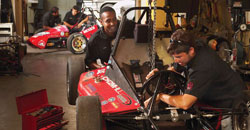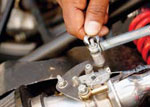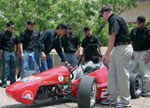Racing to a New Level
UNM Team Goes From 39th to 14th in International Racecar Competition
 The pressure was intense as the unm student team's formula-style racecar pulled into the pit during the 2005 endurance race. There were only three minutes to stop the car and change drivers. This had been the low point of the competition for the 2004 unm team; their car had overheated and they could not continue. The endurance race, a test of overall performance, reliability, and fuel economy, is a challenge for most teams: two-thirds of them do not finish it. (See UNM Engineering, Fall 2004.)
The pressure was intense as the unm student team's formula-style racecar pulled into the pit during the 2005 endurance race. There were only three minutes to stop the car and change drivers. This had been the low point of the competition for the 2004 unm team; their car had overheated and they could not continue. The endurance race, a test of overall performance, reliability, and fuel economy, is a challenge for most teams: two-thirds of them do not finish it. (See UNM Engineering, Fall 2004.)
Mechanical Engineering professor and faculty advisor John J. Russell emphasized it repeatedly: the endurance race was critical. If the team could complete all 22 of the one-kilometer laps, they would have a chance at breaking through to being one of the top 20 finalists worldwide. And here they were in the pit, changing drivers, at the halfway point of the endurance race.
Each moment seemed to drag on. Now Russell couldn’t see the team but he visualized them in the pit, synchronizing their moves, the new driver taking control, starting the car. he held his breath and shut his eyes for a second. Then he heard his wife pam scream, "Yes!" and suddenly he saw car number 22 burst out of the pit. he counted down the remaining 11 laps and saw his team's car cross the finish line. They did it! The team finished the endurance race and broke through a barrier all previous UNM teams had been unable to overcome.
A Real-World Scenario
UNM's student-built racecar went on to place 14th overall in the 2005 formula Society of automotive Engineers (FSAE) competition in Pontiac, Michigan, last May, UNM's best finish ever. The four-day event is the largest international engineering competition in the world.
 The premise set up by the FSAE competition is that a manufacturing firm has commissioned each team to produce a prototype open-wheeled, open-cockpit, formula-style racecar for evaluation as a production item for the nonprofessional weekend autocross racer. approximately 140 teams from around the world compete in seven categories that are judged by hundreds of industry professionals.
The premise set up by the FSAE competition is that a manufacturing firm has commissioned each team to produce a prototype open-wheeled, open-cockpit, formula-style racecar for evaluation as a production item for the nonprofessional weekend autocross racer. approximately 140 teams from around the world compete in seven categories that are judged by hundreds of industry professionals.
To emphasize the real-world scenario, teams are judged on engineering and business outcomes. There are events that measure the car's acceleration, handling, braking, fuel economy, overall performance, and reliability. In addition, it must be easy to maintain, reliable, and affordable. Judges from auto industry management evaluate marketing, design, and manufacturing reports and presentations. The result is an all-encompassing yearlong effort that demands engineering skills, project management, teamwork, and business acumen.
From Start to Finish
 UNM is one of a handful of colleges offering courses designed around the FSAE racecar event. Russell redesigned the courses in 2003. Students on the team begin a three-semester, for-credit course sequence in the spring of their junior year. The first semester is dedicated to the academics of racecar design. In the fall, students build the car, and in the spring, they test it. The class is an alternative to the required senior design project in Mechanical Engineering.
UNM is one of a handful of colleges offering courses designed around the FSAE racecar event. Russell redesigned the courses in 2003. Students on the team begin a three-semester, for-credit course sequence in the spring of their junior year. The first semester is dedicated to the academics of racecar design. In the fall, students build the car, and in the spring, they test it. The class is an alternative to the required senior design project in Mechanical Engineering.
The course sequence is an ideal vehicle for combining engineering, life skills, and experiences that last a lifetime. "The event itself lasts maybe six months in students' minds. The thrill of victory or defeat passes," says Russell. "The total experience lasts forever - the teamwork, the time they put into it, the accomplishments, the experiences they have along the way."
Justin Reddick, a 2005 team member, agrees. "This course changed me. I became much more passionate about engineering," he says. "I was totally immersed in the project from start to finish and there is no better feeling than seeing something that you had a hand in perform so well."
Reliability and Continuity
Throughout the course, Russell emphasized the importance of analyzing, preparation, and testing. "Build in reliability, drive the car smartly by not risking the car, and more than anything - remember that better is the enemy of good enough. No last minute untested improvements," he explains.
One of the keys to the success of the course and the competition is continuity from one year's team to the next. Ryan Chefchis, a senior and the project manager for the 2006 team, says, "It's an evolutionary project. We take what works from last year's car and use it. We fine-tune what doesn't work and change it. But racing is racing - anything could happen. We could be in the first place in the last race and blow a tire. We know that preparation is key, and we'll certainly be prepared."
The 275 additional points from the endurance race helped push the 2005 team from the 2004 39th place finish to 14th place internationally, 10th place nationally, and a new level for UNM. Russell says, "I’m most proud of the way the team put it all together. They were organized, prepared, professional, and on-time for each event. Our team demonstrated it has what it takes to win by performing well in all aspects of the competition. They showed they belong with the best in the world."
